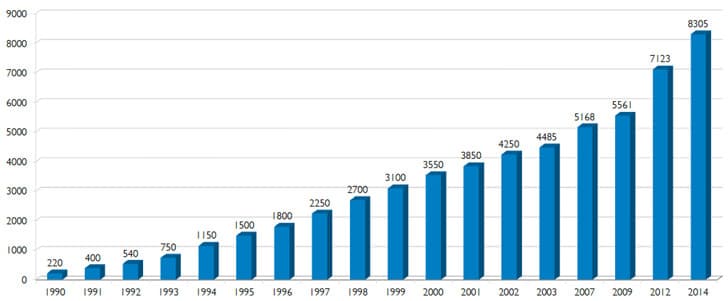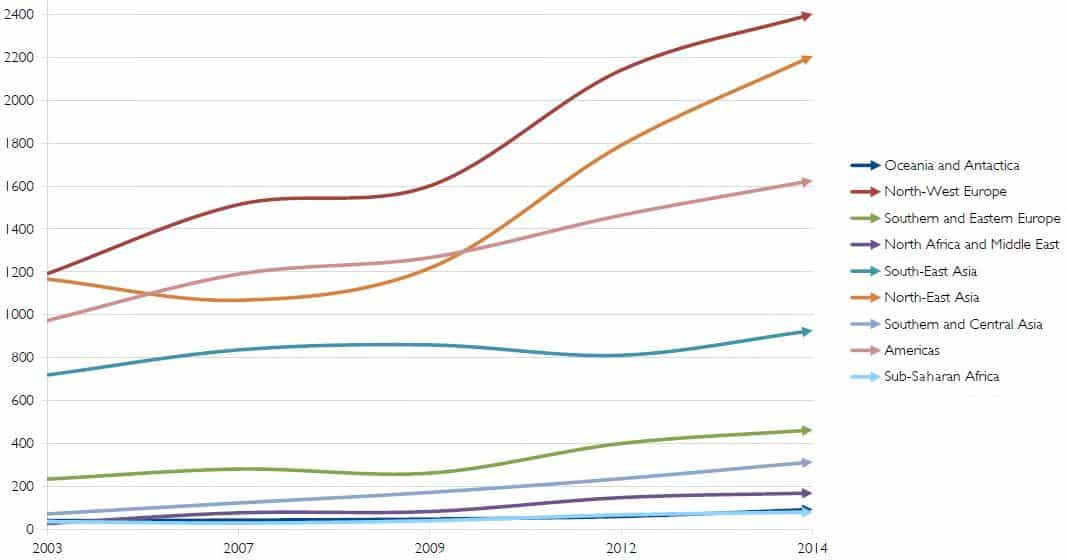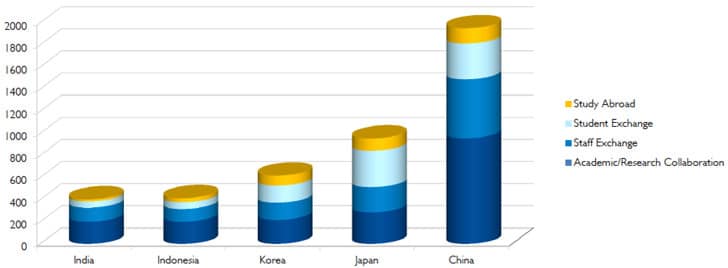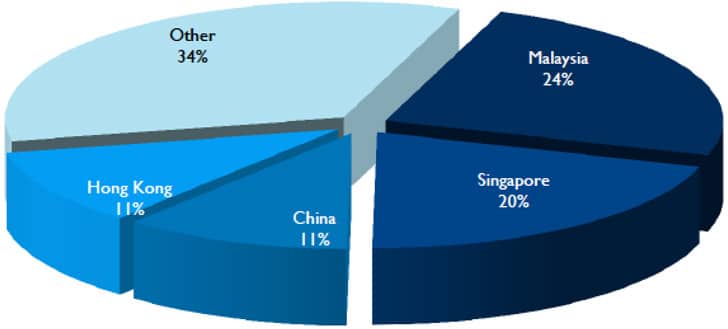International linkages of Australian universities up by 49% since 2009
Recent reports from Universities Australia illustrate that over the past two decades there has been a steady increase in the number of formal agreements between Australian universities and international institutions. The peak body representing the university sector in Australia has been tracking the international linkages of Australian universities on a regular basis since 1991. In June of this year, they released two reports. The first, International Links of Australian Universities: Formal agreements between Australian universities and overseas higher education institutions, maps overall linkage activity, while the second, Offshore Programs of Australian Universities, examines the number and range of educational programmes that are wholly or partly delivered overseas by Australian institutions. So, what do the 2014 reports reveal about the international engagement activities of the Australian higher education sector today? Let’s take a closer look.
How many links?
In 2014, Australian universities had 8,305 formal, institution-to-institution agreements in place with their higher education counterparts overseas. This represents an increase of more than 16% since Australian universities were last surveyed in 2012 – when the number of agreements totaled 7,123 – and an increase of more than 49% since 2009, when the number of agreements was 5,561.
Indeed, as illustrated in the figure below, the number of formal agreements has continued to grow since 1990, when there were around 220 agreements between Australian universities and international institutions.

What kind?
As for the type of international links that Australian universities have established, over 64% of current agreements include a component of academic or research collaboration. Other types of links include cooperation facilitating student exchanges (53.89% of current agreements), staff exchange (45.39%), and study abroad arrangements (23.98%).

Links by region
Turning our focus now to the number of international engagements by region, the findings show that Australian university links continue to be concentrated in North-West Europe – where universities have established 29% of all formal agreements – and North-East Asia, which accounts for 27% of Australia’s overseas linkages.
The following chart illustrates the current breakdown of institutional links by region, as well as the growth in the number of agreements in each global region since 2003.

Links by country
Going deeper now to look at source countries, the findings from Universities Australia show that there has been little movement in the top ten countries for international agreements over the past two decades. China tops the list with 1,184 agreements, followed by the USA (955), Germany (570), and the UK (482).
In one notable shift, however, India bypassed both Indonesia and Sweden for the first time to make the top ten in 2014. From 2003 until 2014, the number of agreements between Australian and Indian institutions increased from 50 to 250 – an increase of 400% over 11 years.
With regard to the type of agreements that are in place with the leading partner country, China, we find that most signed agreements fall into the category of academic/research collaboration, followed by staff exchange, student exchange, and study abroad.

Offshore programmes
In conjunction with its survey on the international links and formal agreements of Australian institutions, Universities Australia also surveyed its members in late 2012 and early 2014 on programmes that they deliver overseas. But given that models and definitions in the broad field of offshore programmes can vary (see, for example, our previous post on Chinese offshore programmes), how did Universities Australia define an “offshore programme” for the purposes of its study? As summarised in the report on Offshore Programs of Australian Universities, an offshore programme can be understood as follows:
- “The programme is conducted in accordance with a formal agreement between the Australian university and an overseas higher education institution or organisation (this may include an offshore campus of the Australian university);
- The programme offered is taught partly or wholly offshore (distance education programmes are included only when there is a formal agreement with an overseas higher education institution/organisation to participate in some way in their delivery);
- The completed programme results in a recognised higher education qualification; and
- The Australian university has developed the programme and has a responsibility for overseeing the academic standards.”
Offshore trends
We’ll close today’s post by outlining the report findings on the number and range of offshore programmes operated by Australian universities:
- Australian universities offer 821 programmes offshore as of 2014;
- Those programmes are delivered almost exclusively offshore for a period of between six months to five years;
- Ten Australian universities provide offshore programmes by distance education, and 14 deliver some aspect of the offshore programme in Australia;
- Most offshore programmes are delivered at the undergraduate level. However, five universities are solely dedicated to the offshore delivery of postgraduate courses;
- The bulk of offshore programmes are delivered in partnership with an international institution. There are, however, 31 offshore Australian university campuses operating at present.
Finally, as illustrated in the figure below, the majority of offshore programmes are delivered in four countries: Malaysia (which accounts for 24% of all Australian offshore programmes), Singapore (20%), China (11%), and Hong Kong (11%).

Most Recent
-
ICEF Podcast: Together for transparency – Building global standards for ethical international student recruitment Read More
-
New analysis sounds a note of caution for UK immigration reforms Read More
-
The number of students in higher education abroad has more than tripled since the turn of the century Read More


















